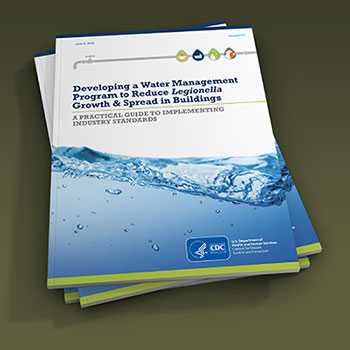Division of Bacterial Diseases (DBD) News Bulletin
Summer 2016, Issue 18
In This Issue

Image: "Developing a Water Management Program to Reduce Legionella Growth and Spread in Buildings," a new toolkit developed by DBD and NCEH, which was released in June.
Water Crisis in Michigan: Legionnaires’ Disease Response
Since January 2016, the DBD Legionella team and partners in the National Center for Environmental Health (NCEH) have been working with public health officials in Michigan to identify buildings at increased risk for growing and spreading Legionella and develop a toolkit to help reduce that risk. In the summers of 2014 and 2015, Genesee County, Michigan, experienced an increase in reported Legionnaires’ disease cases, which coincided with a change to the water supply source for the city of Flint, Michigan. DBD’s Legionella team and NCEH are providing technical assistance to Michigan and Genesee County on Legionella as part of the much larger public health effort by CDC, HHS, and other federal, state, and local partners to address the water crisis in Flint, Michigan. DBD and NCEH will continue to provide this assistance and encourage use of risk reduction measures outlined in the new toolkit (pictured), which was launched with the June 2016 edition of CDC’s Vital Signs on Legionnaires’ disease.
Laboratory Assessment and Training in Bangladesh
In the spring of this year, Stephanie Schwartz, DBD’s global laboratory coordinator, met with longstanding DBD collaborator Dr. Samir K. Saha, professor and head of the Department of Microbiology at the Dhaka Shishu Hospital and the executive director of The Child Health Research Foundation at the Bangladesh Institute, to discuss DBD’s in-country laboratory-related activities. Schwartz was in Bangladesh to join colleagues from the World Health Organization to conduct an in-depth laboratory assessment and laboratory training for PCR methods for detection and characterization of agents in bacterial meningitis and pneumonia. The visit was made on behalf of the Invasive Bacterial Vaccine Preventable Disease Global Surveillance Network.
MPIR Lab Supports the CDC Zika Response
DBD’s Microbial Pathogenesis and Immune Response (MPIR) Laboratory is supporting the CDC Fort Collins and San Juan laboratories’ Zika investigations by providing serology testing for the surge in the number of Zika specimens being sent to CDC during the current outbreak. MPIR is running 2 assays: the anti-Zika IgM assay to detect recent Zika infection and the anti-Dengue IgM to rule out cross-reactive false positives due to the homology between Zika and Dengue. Prior to accepting specimens, MPIR collaborated with CDC Zika subject matter experts to complete risk assessments and safety precautions for handling the samples, finalize the test algorithm, and define the reporting structure.

Photo: DBD staff extend best wishes to Conrad Quinn at a March 30 going away party. Pictured left to right: Lakeisha Swanson, Lucia Tondella, Rana Hajjeh, Conrad Quinn, Stacey Martin, and Xin Wang.
MVPDB Chief Accepts New Position
Conrad Quinn, chief of DBD’s Meningitis and Vaccine Preventable Diseases Branch since mid-2014, has accepted a new position in CDC’s Office of the Director, Office of the Associate Director for Laboratory Science and Safety. On April 4, Quinn, a 15-year CDC employee in MVPDB, became director of the Office of Laboratory Science.
- Page last reviewed: June 30, 2016
- Page last updated: June 30, 2016
- Content source:


 ShareCompartir
ShareCompartir